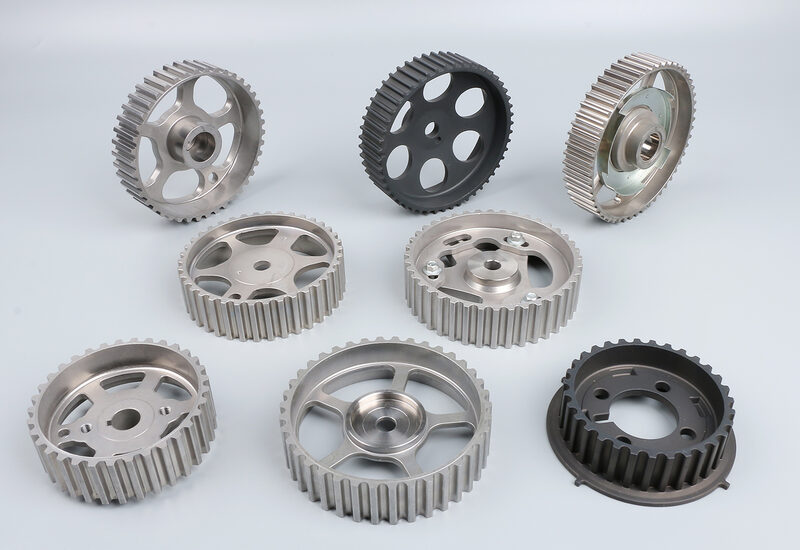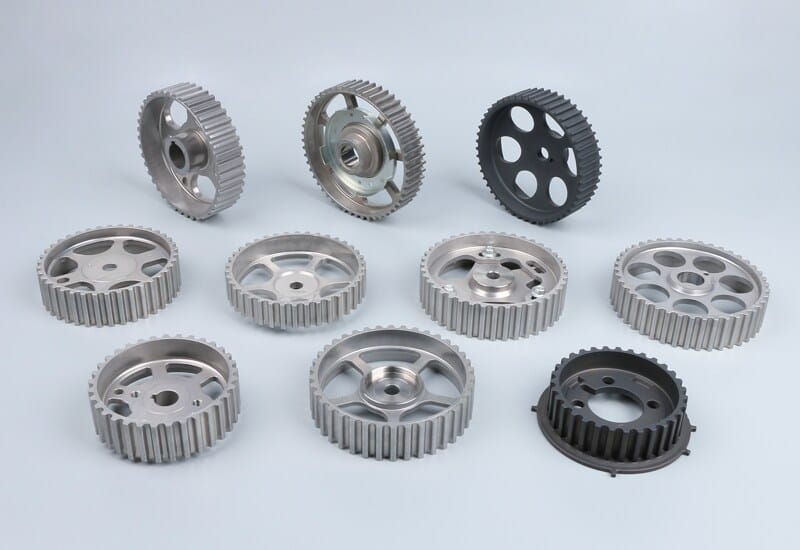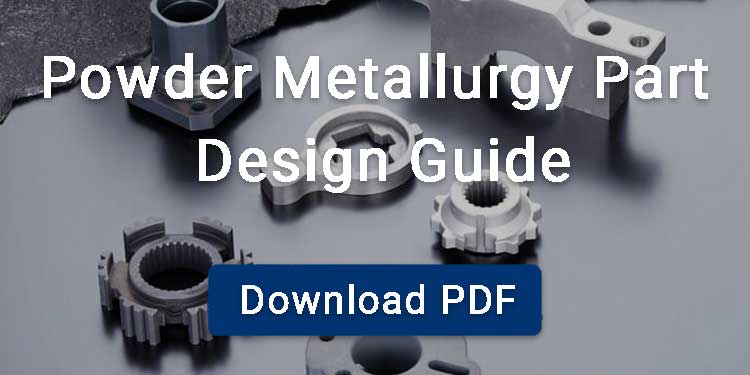A timing belt pulley is a toothed transmission element engineered to mate precisely with a synchronous belt, forming a positive drive system without slip.
The precise engagement of the pulley ensures consistent motion transfer that is essential in applications requiring synchronization. Beyond automotive engines, timing pulleys are widely applied in automation machinery, robotics, and industrial conveyors.

Contents
Functions of a Timing Belt Pulley
The timing belt pulley plays a important role in synchronizing the shaft rotation by guiding and engaging the timing belt to prevent slippage and misalignment. The timing belt, derived from these pulleys, rotates to keep the crankshaft and camshaft rotation concurrent. Another function of this pulley is to transfer power from one shaft to another, carrying torque without slipping, to boost the mechanical efficiency of the engine.
Lastly, its geometry preserves timing stability under variable loads, ensuring reliable performance in demanding applications such as internal combustion engines and industrial automation.

Types of Timing Belt Pulleys
Drive Arrangement
The arrangement of the timing belt pulley with respect to the belt determines its direction of rotation, efficiency, and tension control. That is why selecting the right drive arrangement according to the required machinery is necessary.
Open Belt Drives
Open belt drive is considered one of the simplest derived arrangements in timing belt pulleys. In this setup, a belt wraps around two pulleys, causing both shafts to rotate in the same direction. When power is supplied to the driving shaft, it causes the driving pulley to rotate, which in turn transfers motion to the driven pulley. Here, the belt possesses two ends, one with low tension(slack) and the other with high tension. The tight side generates a greater frictional force, enabling efficient power transfer from the driving pulley to enhance mechanical efficiency.
Crossbelt Drives
In the cross belt, two parallel shafts rotate in opposite directions. The belt wraps around the pulleys in a figure-eight configuration, crossing itself between the pulleys. Wrap angle on both pulleys is high in this arrangement due to the cross-section, leading to higher power transmission for the same pulley size and center distance. A crossbelt drive arrangement is more suitable for low-speed applications, as the belt rubbing against itself can lead to wear and stress under high speeds.
Jockey Pulley Drive
The standard open belt configuration is improved by introducing additional idler (or jockey) pulleys. Open belt drives sometimes suffer from a decreased arc of contact and face difficulty in maintaining proper belt tension. Idler pulleys, positioned between the driving and driven pulleys, increase the belt’s wrap angle around the pulleys and maintain proper tension. The result is improved grip, reduced slippage, and more reliable power transmission.
Fast & Loose Pulleys
This derived arrangement contains two pulleys mounted on the driven shaft, one acting as a fast pulley, which is responsible for power transmission, and the other as a loose pulley. The fast pulley usually rotates with the same speed as the driven shaft rotates because it is keyed to this shaft, whereas the loose pulley rotates freely.
To prevent any sort of axial movement and to keep the loose pulley in place, a cast iron bushing or a metal bushing with a collar is used. This setup allows the driven shaft to be engaged or disengaged from the driving shaft without altering the driving shaft’s speed, enabling efficient control in machinery.
What is timing Belt Pulley Made of?
Steel
To manufacture timing belt pulleys steel is used out of its high tensile strength and hardness. Offering resistance towards wear even under harsh conditions for a prolonged period of time.
Plastics
Acetal, nylon, and polycarbonate materials are key materials for constructing plastic timing belt pulleys. Not only are these affordable and lightweight, but they are also capable of mitigating oxidative conditions easily due to their corrosion-resistant nature. But pulleys made from plastic are not suitable for high temperatures or extreme conditions.
Aluminum
The good thermal resistivity, light-weight nature, good strength-to-weight ratio, and corrosion resistance make aluminium an effective choice for pulleys. Pulleys made from aluminum are used for high-precision machines, but may not be suitable for heavy machinery due to lower strength compared to steel.
Powder metal
Timing belt pulleys can be manufactured using powder metallurgy materials, which provides cost efficiency, near-net-shape accuracy, and reliable dimensional consistency. Powder metallurgy process can form complex geometries in a single pressing.

Signs of a Faulty Timing Belt Pulley
Oil Contamination from Timing Cover Leakage
A visible sign that indicates the bad timing belt pulley is oil leakage. It usually happens if the timing cover becomes cracked, worn, or improperly sealed. Lubricant can seep and contaminate the pulley and belt, causing accelerated wear and increasing the likelihood of overheating if left unattended.
Increased Exhaust Smoke
If your timing belt pulley is damaged, it will cause valve timing irregularities. As a result the engine will need to work harder to maintain optimal operation. This results in decreased combustion efficiency, producing heavy smoke discharge.
Fluctuating Engine RPM
The engine faces fluctuating speed under load in case the pulley is not able to maintain a stable belt engagement. This happens because pulley’s surface wear, bearing degradation, or tooth deformation reduces the precision of shaft rotation.
Interval-Based Degradation
Most manufacturers advise inspection or replacement of timing components between 60,000 and 100,000 miles. Pulley can gradually degrade without indicating visible signs. Neglecting inspection intervals increases the risk of sudden failure, which can lead to costly internal engine damage.
Timing Belt Pulley Installation and Maintenance
Proper installation and upkeep of timing belt pulleys are essential for long-term performance. You must verify the alignment of pulley with precision tools to avoid uneven wear. In order to prevent tooth damage, the installation should be done using recommended techniques rather than force.
Maintenance Tips
- Protecting the shaft from deflection helps maintain tension stability, and routine inspections allow early detection of wear or contamination.
- Clean, debris-free pulleys extend service life.
- Adherence to manufacturer guidelines for tensioning, inspection intervals, and replacement ensures reliable and efficient operation across all applications.
Advantages of Timing Pulleys
Accurate Power Transmission
Timing belt pulleys are responsible for accurate power transmission by eliminating slip as their teeth mesh perfectly with the timing belt. It enables precise synchronization of shaft, which is critical for valve timing in engines and automated machinery.
Quiet and Smooth Operation
Unlike chain drives or gear trains, timing pulleys operate with minimal vibration and reduced noise because their toothed belt design ensures smooth, precise engagement without metal-to-metal contact.
High Efficiency
Timing pulleys minimize energy loss during transmission as their positive engagement reduces friction compared to flat belts.
Low Maintenance
Timing pulleys require less frequent adjustments than conventional belt systems. Proper installation and periodic inspections are generally sufficient to sustain long service life.
Applications of Timing Belt Pulleys
Automotive Industry
Timing pulleys are integral to engine timing, ensuring accurate valve movement and combustion efficiency. Robust pulley types, such as HTD5M, are often used in automotive systems where high torque and reliability are required.
Industrial Machinery
In manufacturing and automation, pulleys are widely applied in conveyors, packaging equipment, and sorting systems. For example:
- Trapezoidal profiles are commonly used in general-purpose machinery.
- Curvilinear HTD designs serve high-load automation lines where torque and speed are critical.
Robotics
Timing pulleys also find their application in robotics, such as:
- GT2 pulleys are particularly valued for fine positional control, enabling accurate movement across joints and axes.
- GT3 pulleys may also be applied when slightly larger increments are acceptable, but precision remains important.
BLUE supplies a broad range of standard sintered timing belt pulleys, all available without tooling fees. Explore our Timing Pulley Shop or download our product lists to find the right model. If your specifications are not listed, we also provide customized design and tooling services.




